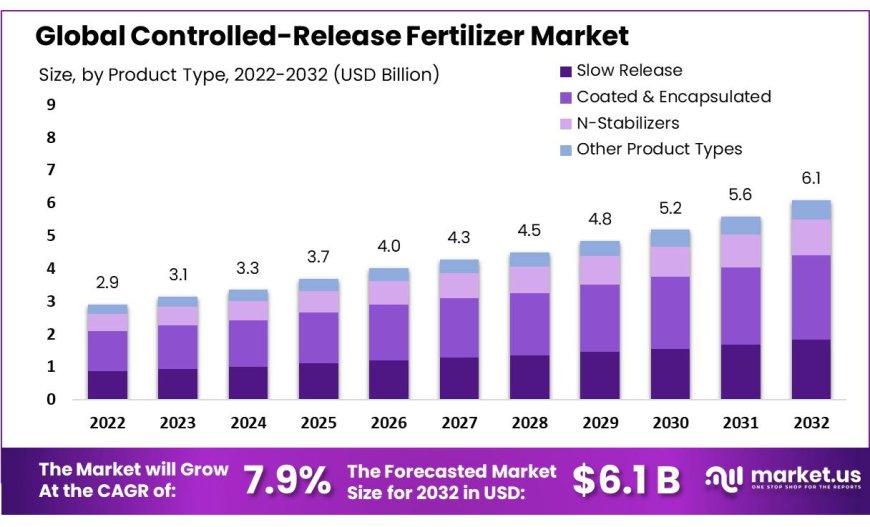Controlled-Release Fertilizers Market 2023 SWOT Study, PESTEL Analysis and Forecast by 2032 - Impact of Corona Virus Outbreak
In 2022, the Global Controlled-Release Fertilizers Market was valued at USD 2.9 Billion; by 2032 it is projected to grow at an annual compounded growth rate of 7.9%.

Market Analysis
The Controlled-Release Fertilizers Market is projected to experience significant growth over the coming years due to factors like increasing demand for sustainable agriculture practices, growing government support for such efforts, and rising awareness about their benefits. CRFs can be found both within agriculture and non-agricultural applications; within agriculture it helps increase yield and quality while simultaneously lowering fertilizer costs while safeguarding the environment.
In 2022, the Global Controlled-Release Fertilizers Market was valued at USD 2.9 Billion; by 2032 it is projected to grow at an annual compounded growth rate of 7.9%.
Download a Sample PDF Report Here: https://market.us/report/controlled-release-fertilizers-market/request-sample/
Analysis of Controlled-Release Fertilizer Market:
Drivers:
- Increasing global population and food demand: The world's population is projected to hit 10 billion by 2050, placing strain on global food supply systems. To meet rising food needs more effectively and meet rising population growth needs, controlled-release fertilizers could play an invaluable role.
- Environmental awareness and sustainable farming practices: Controlled-release fertilizers are more eco-friendly than traditional ones as they reduce nutrient runoff and leaching that pollute waterways and groundwater, improve soil health, and decrease greenhouse gas emissions.
- Technological Advancements: New technologies are being created to develop more efficient and effective controlled-release fertilizers, like those developed by researchers that release slowly over a longer time span and better meet specific crop needs.
- Government Support: Many governments around the world are supporting controlled-release fertilizers as part of their effort to promote sustainable agriculture, with US Department of Agriculture offering subsidies to farmers who use such products.
Restrictions:
- High Cost: Chlorinated Rock Fertilizers are generally more costly than conventional fertilizers due to higher production costs and the necessity of special machinery in applying CRFs.
- Lack of Awareness: Many farmers and growers don't understand the advantages of CRFs or how to effectively use them, which presents a major impediment to adoption in developing nations.
- Stringent Regulations: Certain countries impose stringent regulations on the use of CRFs due to them being considered pesticides.
- Limited availability: CRFs may not be widely available due to being relatively new technology and the market still developing.
Opportunities:
- Increase in Demand for High-Value Crops: CRF is widely utilized to improve crop yield and quality in high-value crops such as fruits, vegetables, and flowers - and its growing demand is expected to bolster its market in coming years.
- Rising awareness of sustainable agriculture: CRF fertilizers offer more sustainable options than their traditional counterparts, with reduced leaching and runoff effects, becoming an increasingly desirable choice among both farmers and consumers as they become aware of agriculture's environmental footprint.
- Precision Farming: Precision farming is an approach to agriculture which uses technology to tailor practices specifically to each crop's individual needs. CRF can be applied in an easily controlled fashion for precision farming to ensure crops receive all of their essential nutrients at just the right time.
- Expansion into new markets: The CRF market remains relatively underdeveloped in certain regions, such as Asia and Africa, providing ample growth potential for manufacturers of CRFs.
Challenges:
- High Cost: CRFs can be more costly than traditional fertilizers, preventing their widespread adoption among farmers in developing nations.
- Complex Application: CRFs require proper application in order to be effective, which may prove challenging for farmers who are unfamiliar with these fertilizers.
- Limited Access: CRFs may not be as readily available to farmers than conventional fertilizers, making them harder to access in remote locations.
- Improper Management: CRFs may become less effective and even harmful if their management is mishandled, including application incorrectly that releases nutrients too rapidly or too slowly, leading to plant deficiencies or toxicities.
Key Market Segments
Based on Product Type
- Slow Release
- Coated & Encapsulated
- N-Stabilizers
- Other Product Types
Based on Form
- Liquid
- Granule
- Powder
Based on Crop Type
- Cereal & Grains
- Fruits & Vegetables
- Oilseeds & Pulses
- Forage & Turf
- Other Crop Types
Based on Application
- Foliar
- Soil
- Fertigation
- Other Applications
Market Key Players
- Yara International ASA
- The Scotts Miracle-Gro Company
- ICL Specialty Fertilizers
- Nutrien Ltd.
- Kingenta Ecological Engineering Group Co., Ltd
- Haifa Group
- R. Simplot Company
- Koch Industries
- Sociedad Química y Minera
- Aglucone Fertilizers GmbH & Co. KG
- Other Key Players
Browse More Report:
https://market-research-updates.blogspot.com/2023/10/recycled-copper-market-2023-research.html
Contact us
Global Business Development Team: Market.us
Market.us (Powered By Prudor Pvt. Ltd.)
Send Email: inquiry@market.us
Address: 420 Lexington Avenue, Suite 300 New York City, NY 10170, United States
Tel: +1 718 618 4351, +91 78878 22626
What's Your Reaction?
 Like
0
Like
0
 Dislike
0
Dislike
0
 Love
0
Love
0
 Funny
0
Funny
0
 Angry
0
Angry
0
 Sad
0
Sad
0
 Wow
0
Wow
0
















































